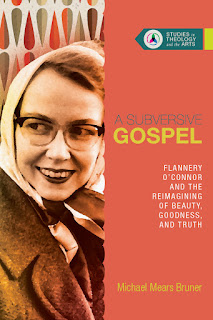"A Subversive Gospel" by Michael Mears Bruner. A Review
A Subversive Gospel: Flannery O’Connor
and the Reimagining of Beauty, Goodness, and Truth
Michael Mears Bruner
IVP Academic
InterVarsity Press
PO Box 1400 Downers Grove, IL 60515
PO Box 1400 Downers Grove, IL 60515
ISBN: 978-0-8308-5066-2; $30.00; October
2017
I can’t even recall how or why it
came about, but around twenty years ago I tripped across Flannery O’Connor’s “A
Good Man Is Hard to Find” and was hooked! Since then I have read most of her
writings and a few works by others analyzing her style and stories. Recently
Michael Mears Bruner, associate professor of practical theology at Azusa
Pacific University in California, and ordained minister in the Presbyterian
Church (USA), has presented his own examination of O’Connor in a 260 page
softback, “A Subversive Gospel: Flannery O’Connor and the Reimagining of
Beauty, Goodness, and Truth,” which is part of IVP Academic’s “Studies in
Theology and the Arts” series. This well-written volume is ideal for O’Connor
aficionados, amateurs and interested authors.
The author, beyond the introduction
and conclusion, works through five lengthy chapters that evaluate O’Connor’s
literary and spiritual formation that shaped and colored her stories. Bruner
shows how the primary shapers of her moral and dramatic vision were Baron Friedrich
von Hügel, Thomas Aquinas via Jacques Maritain, her tussle with debilitating
illness and her Southern habitation. Yet, in the end, the moral and dramatic vision
were genuinely hers; “through her fiction, Flannery O’Connor subverted the
conventional notions of truth, goodness, and beauty, not merely from a position
of Christian dogma but out of an aesthetic impulse” (1). Bruner spends his time in “A Subversive
Gospel” encouraging O’Connor readers to “apply a kind of crucifix hermeneutic to her fiction – a kind of crosshairs reading
that alerts us to the fact that when something violent happens in her stories,
or someone is or says or does something foolish, or something terrible or awful
appears, there is a decent chance that O’Connor is actually trying to show us
something good, true, or beautiful, respectively” (2).
Bruner points out that in her fictions
O’Connor “showed her readers how following Christ is a commitment to follow in
his shadow, which becomes a subversive act aesthetically…, ethically…, and
intellectually….” (9). Further, “that redemption is hard because life is hard,
and life is hard because we are sinners who resist redemption with every fiber
of our being, preferring the easy stroll to the arduous pilgrimage, a
pilgrimage fraught with dragons at the side of the road waiting to devour us”
(73). In fact, the author asserts, in many of O’Connor’s tales “it is not the
devil…but God who is the greatest offense, and his terrible mercy is often more
painful than the devil’s wickedness” (153). One way this shows up is in her
prophets who find that being burned is an occupational hazard, since “burning
functions as a trope in O’Connor’s material and is used to indicate when a true
subversion (read conversion) is
taking place. God’s mercy burns to salvific effect. There is a cost to following Christ in his
“bleeding stinking mad shadow”” (162). This is so because O’Connor “was
interested in portraying her characters’ struggles with redemption, not with
damnation” (183). Indeed, a cruciform shadow lurks through her narratives.
“A Subversive Gospel” gives due
credence to O’Connor’s loyalty to the Catholic Church and Catholic dogma, and
that the dogma didn’t stifle O’Connor but gave her real liberty, since the
“greatest art represents firmly fixed boundaries within which artistic expression is free to roam and reign” (83).
And so her stories “express a fierce dogmatism because the church at its best
has insisted on dogmatic ferocity in its commitment to Scripture and tradition,
and O’Connor founded her very existence in the church” (142). One aspect where
her dogmatism surfaces is in the recognition that grace and nature often dance
together, and “that grace and nature are separated only at our peril.” Therefor
in her works demonic violence “seeks to separate grace from nature, and by so
doing objectifies nature” whereas divine violence “refuses to separate grace
from nature and, in such refusal, thereby grants the recipient of such violence
access to redemptive truth, goodness, and beauty” (150-1). Truly, there is a
cruciform shadow lurking in her stories!
“A Subversive Gospel” was an
enjoyable, reflective volume. O’Connor fans should obtain a copy with speed.
But also, Christian fiction writers need to pour over these pages thoughtfully
and consider their own style. Finally, literature classes in Christian schools
and colleges ought to make it required reading followed by heavy discussion. I
happily and highly recommend the book. It may just be that once you’ve tackled
it, you will see with fresh eyes and notice the cruciform shadow haunting her
stories.
Thanks to IVP Academic for providing, upon my request, the free copy of the book used for this review. The assessments are mine given without restrictions or requirements (as per Federal Trade Commission’s 16 CFR, Part 255).
A copy of the book can by purchased here: "A Subversive Gospel"




Comments